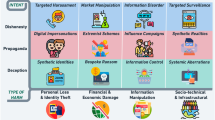Abstract
There is a history of thinking that photographs provide a special kind of access to the objects depicted in them, beyond the access that would be provided by a painting or drawing. What is included in the photograph does not depend on the photographer’s beliefs about what is in front of the camera. This feature leads Kendall Walton to argue that photographs literally allow us to see the objects which appear in them. Current generative algorithms produce images in response to users’ text prompts. Depending on the parameters, the output can resemble specific people or things which are named in the prompt. This resemblance does not depend on the user’s beliefs, so generated images are in this sense like photographs. Given this parallel, how should we think about AI-generated images?



Similar content being viewed by others
Notes
In later work, Walton suggests that the word mechanical in this context is “far from clear” (Walton 2023). He writes instead about the photographic relation and expresses his view in this way: “[T]he feature of photographs that I took to be crucial to their transparency is key to understanding the photographic relation: Photographs depend counterfactually on the objects photographed, even when the beliefs and other mental states of the photographer (and anyone else) are held fixed” (Walton 2023). When I use the word mechanical, I use it to mean this crucial feature.
Christy Mag Uidhir (Uidhir 2012, fn. 7, p. 40) argues that film photography should be understood under the genus of printmaking and therefore that the so-called digital photographs are not really photographs at all. Even so, there is a larger category of images that includes old-school photographs and digital photographs. My use of the word “photograph” in this paper refers to that larger category.
In later work, Walton is explicit that his account should also apply to pictures taken with a digital camera (Walton 2023).
My engagement here with Rini is just to resist her conflation of the two issues. Her primary focus is on the erosion of epistemic authority; that is, what happens when it becomes unwise to presume that recordings provide knowledge. Addressing that is beyond the scope of this paper.
Walton would say that the viewer does not see Lincoln wearing a funny hat but does see both Lincoln and a funny hat. See his parallel discussion of photographic composites made in a darkroom from multiple negatives (Walton 1984, p. 268–9). Cavedon-Taylor would say that the resulting composite is not “strictly speaking, a photograph” but instead a “photomontage” (Cavedon-Taylor 2013, p. 288).
See Walton Walton (2023) on the distinction between the depictive relation and the photographic relation.
One might press the objection by noting that the training set for the algorithm probably includes paintings and illustrations of Lincoln as well as photographs. Those contribute in some small way to the output and thus introduce a small human element in Fig. 2, making it less than fully mechanical. Regardless, we can imagine—one could even construct—a generative AI trained only on photographs. The conclusion that the looking at the output of such a generative AI would be like seeing in a photograph remains odd.
References
Cavedon-Taylor D (2013) Photographically based knowledge. Episteme 10(3):283–297
Currie G (1995) Image and mind: film, philosophy and cognitive science. Cambridge University Press, Cambridge
Finnegan CA (2005) Recognizing Lincoln: image vernaculars in nineteenth-century visual culture. Rhetor Public Aff 8(1):31–58
Holmes OW (1859) The stereoscope and the stereograph. Atl Mon 3:738–748
Jonathan C, Aaron M (2004) On the epistemic value of photographs. J Aesthet Art Crit 62(2):197–210
Meskin A, Cohen J (2008) Photographs as evidence. In: Walden S (ed) Photography and philosophy: essays on the pencil of nature. Blackwell, New York
Mizrahi V (2021) Seeing through photographs: photography as a transparent visual medium. J Aesthet Art Crit 79(1):52–63. https://doi.org/10.1093/jaac/kpaa009
Nanay B (2010) Transparency and sensorimotor contingencies: do we see through photographs? Pac Philos Q 91(4):463–480
Noël C (1995) Towards an ontology of the moving image. In: Freeland Cynthia A, Wartenberg Thomas E (eds) Philosophy and film. Routledge, London, pp 68–85
Rini R (2020) Deepfakes and the epistemic backstop. Philos Impr 20(24):1–16
Tarbell IM (1900) The life of Abraham Lincoln, vol 2. The Doubleday & McClure Co., New York
Uidhir CM (2012) Photographic art: an ontology fit to print. J Aesthet Art Crit 70(1):31–41. https://doi.org/10.1111/j.1540-6245.2011.01496.x
Walton KL (1984) Transparent pictures: on the nature of photographic realism. Crit Inq 11(2):246–277
Walton KL (2012) Fotografische Bilder. In: Julian N-R, Jakob S (eds) Fotografie zwischen Dokmentation und Inszenierung. Hatje Cantz Verlag, pp 11–28. Translated as “Photographic Pictures”, available from the author’s website. https://sites.lsa.umich.edu/kendallwalton/wp-content/uploads/sites/225/2015/01/walton_photographicpictures.pdf. Accessed 26 Oct 2023
William J (1896) The will to believe. In: Castell A (ed) Essays in pragmatism. Hafner Publishing Co., New York, pp 88–109 (Originally published June)
Author information
Authors and Affiliations
Corresponding author
Additional information
Publisher's Note
Springer Nature remains neutral with regard to jurisdictional claims in published maps and institutional affiliations.
Thanks to Evan Malone, Dan DiTursi, Jason D’Cruz, and Ron McClamrock for helpful discussion of these issues.
Rights and permissions
Springer Nature or its licensor (e.g. a society or other partner) holds exclusive rights to this article under a publishing agreement with the author(s) or other rightsholder(s); author self-archiving of the accepted manuscript version of this article is solely governed by the terms of such publishing agreement and applicable law.
About this article
Cite this article
Magnus, P.D. Generative AI and photographic transparency. AI & Soc (2023). https://doi.org/10.1007/s00146-023-01817-8
Received:
Accepted:
Published:
DOI: https://doi.org/10.1007/s00146-023-01817-8




